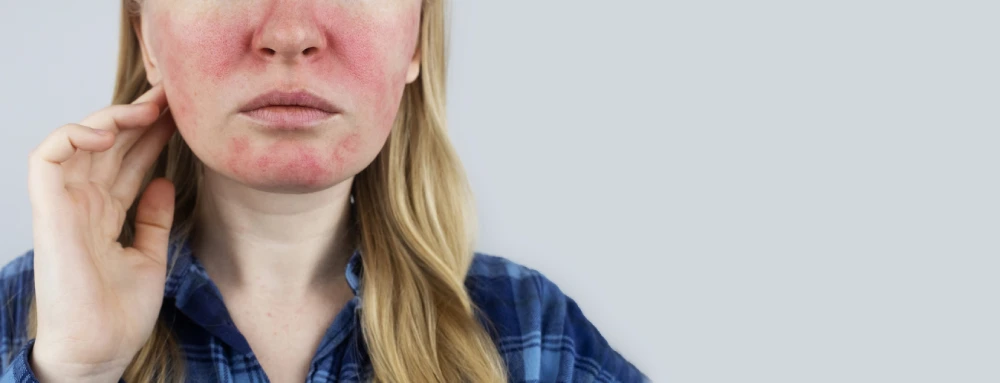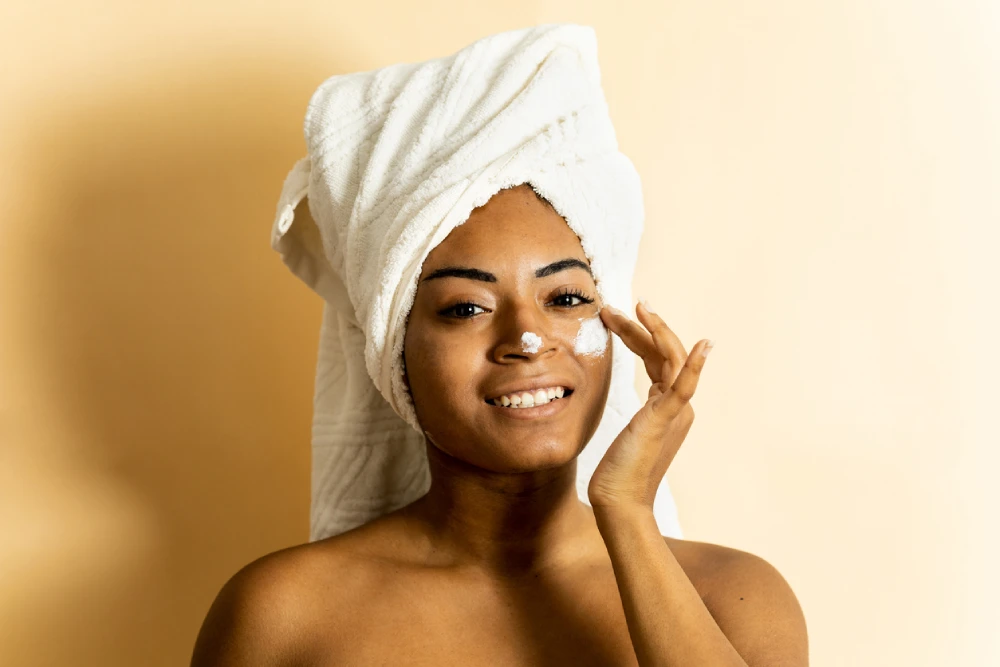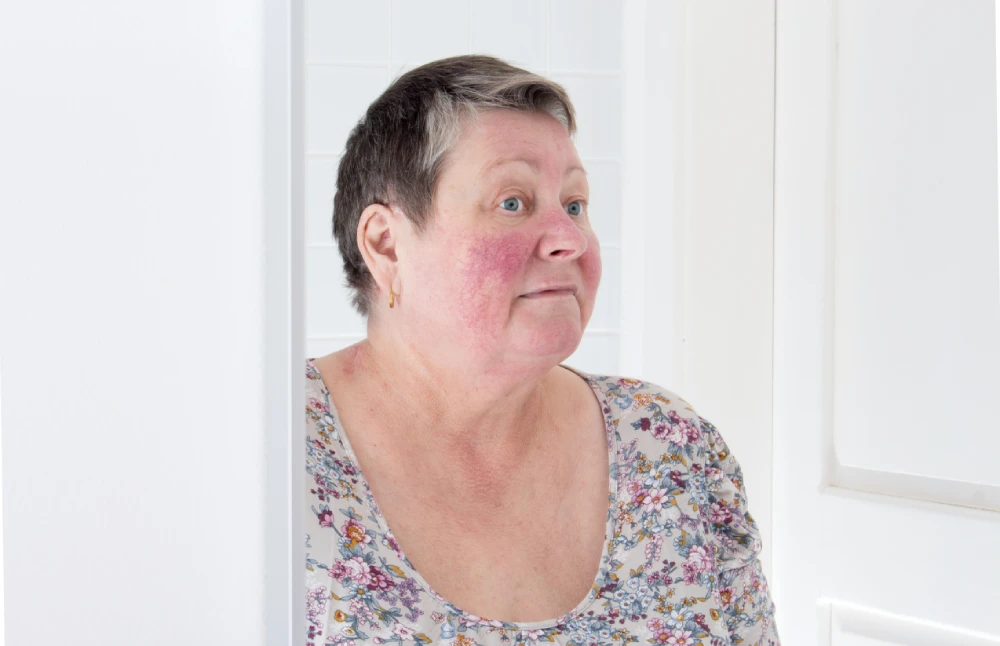Can you imagine waking up each morning only to find the discomfort of flushed, irritated skin that’s sensitive to the touch?
While this may sound intense, it’s a daily reality for many.
Rosacea is more than just occasional redness; it’s a persistent skin condition that can cause discomfort, self-consciousness, and frustration, and according to the Acne and Rosacea Society of Canada, it affects more than three million Canadians.
While the exact cause of rosacea remains a mystery, certain triggers such as sun exposure, intense exercise, stress, spicy foods, and extreme temperatures can make symptoms flare up unexpectedly.
If you’ve struggled with redness, visible blood vessels, or skin sensitivity, you’re not alone. The good news? With the right approach, you can manage rosacea effectively and regain control over your skin health.
In this guide, we’ll explore 8 essential tips to help reduce flare-ups and keep your skin calm and balanced. Let’s dive in!

Understanding Rosacea – Symptoms, Triggers & Risk Factors
Rosacea is a chronic inflammatory skin condition that primarily affects the face, typically the cheeks, nose, chin and forehead.
Early signs of this condition include occasional redness or blushing, but over time becomes persistent redness and irritation, and can include a variety of other symptoms.
It typically occurs in cycles of flare-ups and remissions. Common symptoms include:
- Persistent facial flushing
- Visible blood vessels
- Sensitivity
- A burning or stinging sensation
- Dry skin
In more severe cases, thickened skin or eye irritation (ocular rosacea) may also occur.
While rosacea is not contagious, its symptoms can significantly impact self-esteem and quality of life, making effective management crucial.
Environmental and Lifestyle Triggers
Certain environmental and lifestyle factors can trigger or worsen rosacea symptoms.
- Sun exposure, extreme temperatures, wind, and humidity are common culprits.
- Hot drinks, spicy foods, alcohol, and caffeine are known dietary triggers.
- Emotional stress and intense physical activity can also lead to flare-ups.
Understanding these triggers can help individuals take proactive steps to minimize their exposure and reduce symptoms.
Genetic and Physiological Factors
While there is no known cause for rosacea, it typically develops in early adulthood, with symptoms often presenting between age 30 and 50.
However, some common elements point towards increased risk of development among certain populations.
While rosacea can affect anyone, Cleveland Clinic states it affects women more often than men, and the Canadian Skin Patient Alliance claims up to 40 percent of those diagnosed also have a history of rosacea in their family.
Furthermore, while it may present more visibly on fair skin, rosacea does not discriminate and can affect people of any race or ethnicity.
Understanding these factors helps in self-advocating for support, and knowing when to turn to your healthcare providers.
Rosacea Diagnosis – Clinical Assessment & Self-Monitoring
Getting the right diagnosis is the first step in effectively managing rosacea. Since symptoms can resemble other skin conditions, it’s important to work with a healthcare professional to determine the best course of action.
How Healthcare Professionals Evaluate Rosacea
A dermatologist or healthcare professional diagnoses rosacea through a clinical examination. There is no definitive test for rosacea, so doctors assess symptoms and medical history.
They may use imaging tools to evaluate the severity of blood vessel involvement and recommend specific treatments accordingly.
Differentiating from Similar Skin Conditions
Rosacea can be mistaken for acne, eczema, or allergic reactions. Unlike acne, rosacea lacks blackheads and is primarily characterized by persistent redness and visible blood vessels.
Eczema typically causes itchiness and dry patches, while allergic reactions may present with temporary hives or swelling. Consulting a professional ensures accurate diagnosis and effective treatment.
Tips for Tracking Flare-ups and Triggers
Keeping a rosacea diary helps individuals identify personal triggers. Tracking food intake, skincare products, environmental factors, and stress levels can reveal patterns in flare-ups.
Using apps or journals to log daily skin conditions allows for better self-management and helps healthcare providers refine treatment plans.

Rosacea Treatment – 8 Tips for Reducing Rosacea Symptoms
Managing rosacea requires a multi-faceted approach, from daily skincare to professional treatments.
Below, we share eight essential tips that can help reduce flare-ups and keep symptoms under control.
1. Build a Customized Skincare Routine
A gentle skincare routine is essential for managing rosacea and preventing irritation.
Selecting fragrance-free, hypoallergenic cleansers and moisturizers is key to maintaining the skin barrier and reducing sensitivity. Option+ face cleansers and moisturizers offer a great solution.
Additionally, avoid harsh exfoliants, alcohol-based toners, and products containing artificial fragrances, as these can trigger flare-ups.
When drying your face, pat the skin gently instead of rubbing with a towel to minimize friction and irritation.
2. Identify and Avoid Personal Triggers
As mentioned above, identifying specific triggers is crucial for preventing rosacea flare-ups.
Common triggers include spicy foods, alcohol, caffeine, and extreme temperatures, but everyone’s skin reacts differently. Using mobile apps designed for skincare tracking or simply maintaining a diary can provide valuable insights.
Once you identify your personal triggers, take proactive steps to minimize exposure and keep symptoms under control.
3. Leverage Over-the-Counter Treatments
Over-the-counter treatments can provide relief, especially when combined with prescription regimens.
While your fragrance-free skincare products are great over-the-counter solutions, for more challenging rosacea symptoms, you may require prescription topicals. Some common options include:
These topicals can help reduce redness, inflammation, and lesions. For those that require systemic treatment, Isotretinoin and Doxycycline are often prescribed.
It’s important to consult a healthcare provider to determine which treatment is right for you and ensure safe integration into your skincare routine.
4. Prioritize Sun Protection
Sun exposure is one of the most common triggers for rosacea flare-ups, making daily sun protection essential.
Use a broad-spectrum 30+ SPF sunscreen formulated for sensitive skin to prevent irritation. Mineral-based sunscreens containing zinc oxide or titanium dioxide are often recommended as they provide effective protection without causing breakouts.
5. Manage Stress and Support Physical Wellness
Stress is a well-known trigger for rosacea, making effective stress management a key component of symptom control.
Practicing relaxation techniques such as meditation, deep breathing, and progressive muscle relaxation can help regulate stress levels, while regular exercise can help improve overall well-being and support circulation and skin health.
If you experience an increase in irritation during or after working out, consider reducing the intensity of your session, drinking cold water, and rinsing your face with cool water afterward to ease any discomfort.
Furthermore, prioritizing sleep hygiene, such as maintaining a consistent bedtime routine and reducing screen time before bed, can further reduce stress and improve rosacea symptoms.
6. Consider Natural & Home Remedies
Some natural remedies may help soothe rosacea-prone skin when used alongside conventional treatments. However, it’s important to keep in mind that many natural products can have interactions with other medications.
Before beginning any new regime or making changes to your treatment plan, it is crucial to speak to your PharmaChoice pharmacist to ensure they are complementary and there is no risk of potential drug interactions.
Green tea extract, niacinamide, and licorice root have anti-inflammatory properties that can calm redness and irritation. Aloe vera gel is another natural option that provides cooling relief.
However, it’s essential to test any new remedy on a small area of the skin first and consult with a healthcare professional to avoid adverse reactions.
While natural remedies can be beneficial, they should complement, not replace, medically approved treatments.
7. Use Professional Advice for Personalized Care
Pharmacists and dermatologists can provide guidance on medication use, skincare choices, and lifestyle modifications to improve symptoms.
A pharmacist can also recommend alternative treatments if a certain medication is not delivering the desired results.
8. Incorporate Regular Check-ups and Monitoring
Ongoing monitoring is essential for long-term rosacea management.
Since rosacea symptoms can evolve over time, regular consultations with your healthcare team will help ensure that your treatment plan is up-to-date and tailored to your specific needs as they change.
If symptoms worsen or new triggers emerge, revisiting your healthcare provider ensures that you receive the right support.
By staying proactive, you can effectively control rosacea and prevent future complications.

Preventing and Managing Rosacea Flare-Ups Beyond The Tips
Even with a solid treatment plan, managing rosacea is an ongoing process. Beyond the essential tips above, adopting proactive strategies can help minimize flare-ups and keep symptoms under control for the long term.
- Recognizing Early Warning Signs: Early signs of a flare-up include increased facial warmth, redness, or itching. Taking proactive measures such as applying cool compresses and avoiding known triggers can prevent symptoms from escalating.
- Long-Term Maintenance Strategies: Consistently following a daily skincare routine, sun protection regimen, and stress management plan helps maintain skin health and prevent flare-ups.
Integrating Professional Care with Self-Care
Combining professional guidance with daily self-care practices is essential for effectively managing rosacea. A well-rounded approach ensures better control over symptoms and long-term skin health.
- When to Seek Further Medical Help: If rosacea worsens despite self-care measures, professional intervention is necessary. Symptoms such as persistent redness, thickened skin, or eye involvement warrant medical attention. A PharmaChoice pharmacist can guide patients in seeking specialized dermatological care.
- Building a Collaborative Rosacea Treatment Plan: A combined approach involving dermatologists, pharmacists, and self-care strategies enhances treatment success. Coordinating professional care with daily management leads to better outcomes and improved quality of life.
Learn More About Rosacea Treatments at Your Local PharmaChoice Pharmacy
Rosacea is a complex but manageable skin condition. By identifying triggers, following a structured skincare routine, using prescribed treatments, and integrating professional care, individuals can effectively reduce symptoms and improve skin health.
Visit your nearest PharmaChoice pharmacy today for expert advice on managing rosacea—our local pharmacists are here to help you find the best treatment options tailored to your skin’s needs!



